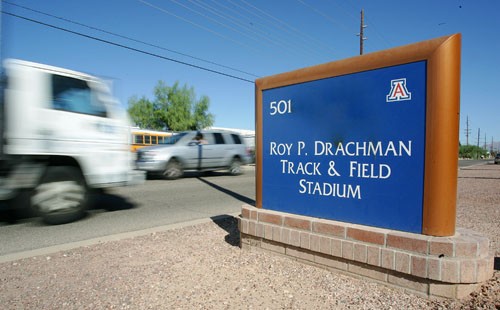Ask the casual Arizona fan where the Arizona soccer and track and field squads have their home competitions, and they’ll probably have to Google it.
Both programs are separated from other UA sports, most of which compete on campus. They practice and compete at the Rincon Vista Sports Complex on 15th Street and Plummer Avenue.
The facility includes two miniature stadiums and a practice field broken up into three sections: the Rincon Vista Sports Complex, for Arizona intramurals and club sports, Murphey Field at Mulcahy stadium, for soccer, and Roy P. Drachman Track and Field Stadium.
“”Ideally, if we had some space on campus it would help with more crowd support. A lot of times people don’t know that (soccer) and track are even out here,”” women’s soccer head coach Dan Tobias said. “”It’s only a mile away from McKale but a lot of it is just convenience.””
Roy P. Drachman Stadium and Mulcahy Stadium sit side by side, with a field house that separates the two stadiums. The field house, which includes a training area, ticket office, official’s area and public restrooms, was completed in 2007.
The Arizona track and field squad moved to Drachman Stadium in 1981, moving away from their old home at Arizona Stadium. Since moving to Drachman Stadium, several improvements have been made to the complex, which seats 5,000.
“”The advantages of our facility are that being away from the campus, it’s strictly going to be used by the track and field program,”” said track and field head coach Fred Harvey. “”We’re able to lock things up at the end of the day so we’re able to hang on to equipment and surface for a longer period of time, because there is less wear and tear.””
Harvey said improvements to the stadium will continue. A permanent building with a control booth is expected to be added before the start of the season. The booth will stretch the width of the track and will be used to control the timing system at track meets, replacing the temporary tents that have been used in the past.
“”It’s not a situation where we’re being neglected out there,”” Harvey said. “”As a coach, you would like to see things done out there every single year.
“”If something was done to the football stadium every year,”” Harvey added, “”I’m sure coach Stoops would be ecstatic, but some things are controlled by budgetary things which everyone is going through right now in this country.””
The Arizona soccer team has seen Mulcahy Stadium vastly improve over the years. When soccer moved into the stadium in 1996 — after playing its games at Pima Community College during its first two years — all that existed was a grass lot.
“”The administration has done a good job of making this into a stadium (over the years),”” Tobias said. “”I remember it was just a field with a chain-link fence when I first got here.””
Though the team eventually hopes to play on campus, Tobias is focused on making more improvements to Mulcahy Stadium. He envisions stands on the east side of the stadium, a big screen scoreboard, an extended press box and a new lighting system.
“”Soccer is the youngest sport at the UA; it’s only been here since 1994, so we want to just keep building to improve the program,”” Tobias said.
The lighting system is high on the priority list, considering several areas of the field have dark spots.
“”It’s just a matter of raising the money and doing it,”” Tobias said of the lights.
As far as recruiting goes, both Harvey and Tobias have said that their location hasn’t affected the ability to attract athletes.
“”I’ve never had a recruit come down to a decision based upon the track being off campus,”” Harvey said.
Some of the current athletes like the stadiums but admit the location can be inconvenient when trying to get to class or to practice.
“”My freshman year my first thought was, ‘How I will get to practice?’ because I didn’t have a car then,”” senior high jumper Liz Patterson said. “”But the track’s in good condition and in the spring the grass is really green. It looks really pretty, plus you have a nice view of the mountains. I like it.””
Besides travel issues, the location can also hinder attendance and crowd support.
“”I think the stadium is beautiful, but at the same time, as a sport it kind of disconnects us from the campus,”” sophomore soccer player Renae Cuellar said. “”If we were on campus, it would draw more attention to our program.””
Despite being off campus, both teams are satisfied with simply having their own fields.
“”It’s really grown and it will continue to grow in the future,”” Tobias said. “”I think we have a great stadium environment, and we’ll continue improving it. As long as we continue to improve the program and product on the field, the surrounding area will improve.””









